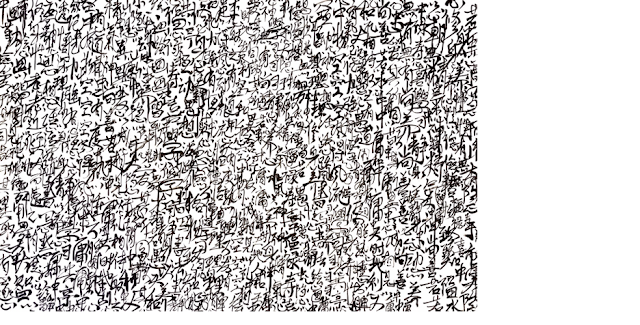意念
 |
| 意念. (2019) |
Catalogue Essay
意念: The Gesture of Thought and the Discipline of Mind
This work operates in a field of tension between the monumental and the minute, the expressive and the disciplined, the bodily gesture and the textual tradition. At its core is the term 意念 — intention, thought, or directed consciousness — enacted not merely as meaning but as material brush presence.
The Monumental Brushwork: Intention Made Visible
The two characters 「意念」 appear as vast, tidal forms. The brush no longer confines itself to the limits of standard script; instead, it arcs, swells, and sweeps like waves breaking against the page. These strokes are not writing in the conventional sense; they are gestures of energy, the body’s intention transcribed directly into ink.
Here, the artist makes thought itself visible. Intention is no longer hidden in the mind; it erupts onto the paper in bold arcs. This embodies a Daoist-Buddhist paradox: to express that which is formless, one must use form.
The scale of the characters suggests not only meaning but movement. The viewer’s eye follows the brush like a dancer’s arm, like a breath exhaled in meditation. It is not a static script but an event of writing.
The Sutra Script: Anchoring the Gesture
Below, the dense regular script recalls sutra transcription. Unlike the wild monumentality above, this part adheres to rhythm, repetition, and textual fidelity. The hand is smaller, precise, measured. The very act of writing sutra passages has historically been a form of meditation, a devotional discipline.
Placed beneath 「意念」, the sutra writing functions as both foundation and counterpoint: it grounds the explosive gesture above in a lineage of teaching, even as it risks being overshadowed by it.
Philosophical Resonances
-
Buddhist Thought: The sutra below points toward the practice of mindful awareness — not suppressing thoughts, but seeing their arising and dissolving. The bold 「意念」 enacts the very arising of thought as a wave.
-
Daoism: The brush arcs echo Daoist ideas of spontaneity (ziran) and flow (dao). Though “intention” is the subject, the strokes feel almost beyond intention, carried by rhythm and qi.
-
Modern Aesthetics: There is an echo of Western gestural abstraction here — Franz Kline or Cy Twombly — but unlike those, the strokes are inseparable from language, even as they verge on painting.
Psychoanalytic Reflection
In Lacanian terms, the sutra writing below belongs to the symbolic order (law, language, repetition), while the giant 「意念」 gestures enact the imaginary and the real — the eruption of unconscious drive into form. The artist stages intention as both disciplined thought and uncontrollable eruption.
The Artist’s Intention
This work can be read as a meditation on the instability of thought. 「意念」 is never pure; it arises, swells, and dissolves. The sutra beneath reminds us to observe without attachment, to recognize thought as transient.
By juxtaposing the monumental and the minute, the artist seems to suggest: intention is both a vast wave and a disciplined point, both a storm and a scripture.
Exhibition Wall Text
意念: The Shape of Thought
This work stages the paradox of thought itself.
At the top, 「意念」 — “intention, thought” — is written in sweeping arcs, transforming brushstroke into pure movement. Below, sutra script anchors the work in discipline and tradition.
The piece enacts the cycle of mind: thoughts arise like great waves, bold and unstoppable, yet they are also observed, transcribed, and dissolved. Gesture and scripture meet here — a dialogue between freedom and discipline, emptiness and form.


Comments
Post a Comment